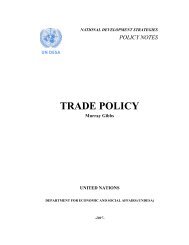16th Meeting of Senior Fellowships Officers of the ... - Development
16th Meeting of Senior Fellowships Officers of the ... - Development
16th Meeting of Senior Fellowships Officers of the ... - Development
Create successful ePaper yourself
Turn your PDF publications into a flip-book with our unique Google optimized e-Paper software.
48<br />
<strong>16th</strong> <strong>Meeting</strong> <strong>of</strong> <strong>Senior</strong> <strong>Fellowships</strong> <strong>Officers</strong> <strong>of</strong> <strong>the</strong> United Nations System and Host Country Agencies<br />
Europe, Asia and <strong>the</strong> Middle East and with a consortium <strong>of</strong> some sixty universities.<br />
OAS was in <strong>the</strong> process <strong>of</strong> setting up a programme for vocational training geared toward<br />
non-academics and welcomed any advice from <strong>the</strong> participants <strong>of</strong> <strong>the</strong> <strong>Meeting</strong> <strong>of</strong><br />
<strong>the</strong> <strong>Senior</strong> <strong>Fellowships</strong> <strong>Officers</strong> in that regard.<br />
Intervention by Mr. Maurice Lelievre, Programme Manager, Canadian Bureau for<br />
International Education (CBIE)<br />
163. Mr. Lelievre informed <strong>the</strong> participants that his organization, CBIE, had been placing<br />
UN fellows in Canada for 19 years. The organization was funded entirely by <strong>the</strong> Canadian<br />
International <strong>Development</strong> Agency (CIDA) and, <strong>the</strong>refore, no fees were charged<br />
when UN agencies sent a placement request. When CBIE started in 1987, <strong>the</strong>re were<br />
eight UN agencies which relied on its services. Currently, WHO and IAEA were its<br />
main clients.<br />
N. Presentation on <strong>the</strong> Implementation <strong>of</strong> <strong>Fellowships</strong>/<br />
Scientific Visits under <strong>the</strong> New Technical Cooperation<br />
Structure, by Ms. Nathalie Delhommeau, Programme<br />
Management Assistant, Division for Africa,<br />
International Atomic Energy Agency (IAEA)<br />
164. Ms. Delhommeau noted that <strong>the</strong> fellowships programme was a major part <strong>of</strong> IAEA’s<br />
Technical Cooperation activities. <strong>Fellowships</strong> were awarded ei<strong>the</strong>r as part <strong>of</strong> a technical<br />
cooperation project or on an individual basis as a direct contribution to <strong>the</strong> manpower<br />
development <strong>of</strong> a country’s atomic energy programme for peaceful purposes. While<br />
most <strong>of</strong> <strong>the</strong> awards covered training periods <strong>of</strong> twelve months at a single institution,<br />
some long-term awards were granted for four-year studies leading to an academic degree.<br />
Besides fellowships <strong>of</strong> a minimum assignment <strong>of</strong> one month, her agency arranged<br />
also study tours <strong>of</strong> up to two weeks.<br />
165. The new structure <strong>of</strong> IAEA’s DTC (cf. para. 74), introduced in December 2005,<br />
did not include a Fellowship Section any more, but consisted <strong>of</strong> four geographical<br />
divisions, each <strong>of</strong> which had two sections. Commenting on <strong>the</strong> selection procedure,<br />
Ms. Delhommeau explained that after a programme had been designed, nominating<br />
countries sent applications to IAEA. The sections pre-screened those applications,<br />
after which <strong>the</strong>y were sent to a technical <strong>of</strong>ficer for evaluation, <strong>the</strong>n to <strong>the</strong><br />
programme <strong>of</strong>ficer and back to <strong>the</strong> section for processing. A project started with a<br />
request from a member country and was implemented by several stakeholders such<br />
as national institutions, partner institutions in o<strong>the</strong>r member states, donors and<br />
financial partners as well as o<strong>the</strong>r IAEA Departments. The TC programme obligated<br />
80 million US dollars in 2005. All IAEA member states were eligible for TC<br />
assistance: 114 recipient countries benefited from national, regional or interregional<br />
projects; 80% <strong>of</strong> recipients were non-nuclear power countries. The most important<br />
recipient region was Africa with 38 benefiting countries among which 22 Least De-

















